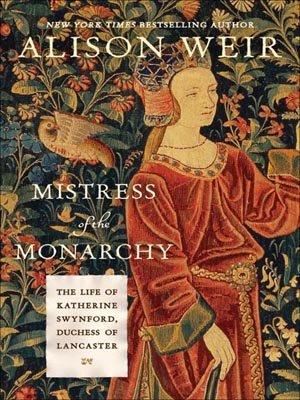Mistress of the Monarchy: The Life of Katherine Swynford, Duchess of Lancaster

Mistress of the Monarchy is a biography of Katherine Swynford, the Duchess of Lancaster. Swynford was the long-time mistress and eventual third wife of John of Gaunt. She also became the ancestor of every English monarch since 1461 as well as such notable personages such as George Washington, Thomas Jefferson, John Adams, Franklin Roosevelt, Princess Diana, Sir Winston Churchill, and George Bush.
Author Alison Weir is a prolific historian who has authored many books, non-fiction and novels, about members of the royal family. Weir did a meticulous job in researching this book, but despite her efforts, little information about Katherine has survived. So she describes those who surrounded Katherine, including her brother-in-law Thomas Chaucer, and the particularities of the time.
The most interesting aspect of the book is the insight she provides into life in the 1300s. The cultural trends she describes, from the tendency to marry young (Katherine married between twelve and thirteen years of age and had her first child one year later) to the debilitating effects of the Black Death gives readers a vivid insight into the challenging environment people lived in at that time. Weir describes the vast wealth and luxury of the noble class, the resentment of the common people, the difficulties of battle, relations between states and high-ranking people, moral codes, lawlessness at the borders, the importance of religion and the roles of women.
The main details readers can infer about Katherine is that she was beautiful, intelligent, accomplished, discreet, good with children, didn’t abuse her influence and kept on good relations with people. While the book opens with an intriguing scene in which John of Gaunt rode around estates with mistress, holding her bridle in public (a public sign of his possession of her) and in the presence of his own wife, Weir doesn’t return to this sense of confrontational scandal later in the book. Besides the fact that the affair and the later marriage were scandalous, the focus remains on Katherine’s discretion and devotion.
Given the lack of information available about Katherine, the title used in the UK version, Katherine Swynford: The Story of John of Gaunt and His Scandalous Duchess, gives a more accurate impression of the book. The figure of John of Gaunt comes through more clearly than does Katherine, as do his first two wives and his dealings with various heads of state. Readers see his love for his first wife, his propensity toward promiscuity, his religious repentance and renewed devotion to his second wife, his bravado in battle, his relations with his relatives and children.
The strength of the book lies in the detailed historical research, the sense of place and time and the resurrection of a forgotten matriarch. Occasionally, the voice loses its vigor, descending into extensive genealogical information or architectural descriptions. Since Katherine’s main contribution to history was her romantic liaison and her descendants and the available details of her personal life are few, there is little narrative arc or tension to propel readers through the book. For those with an interest in the middle ages or in royal history, this is a valuable reconstruction of an overlooked woman and a fascinating historical period.